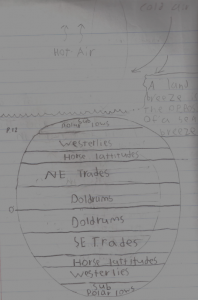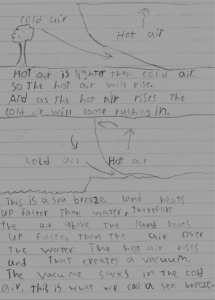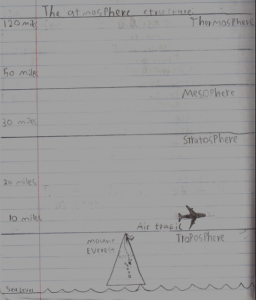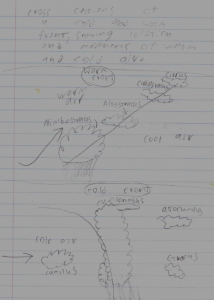Weather Merit Badge Report
Dante Massaro
[1] Define meteorology. Explain what weather is and what climate is. Discuss how weather affects farmers, sailors, aviators, and the outdoor construction industry. Tell why weather forecasts are important to each of these groups.
Meteorology is the study of weather and the atmosphere. Weather is the movement of air around us. The primary driver of weather is the sun.
The sun causes the air to heat up and when it heats up it rises and then colder rushes in to fill in the gap. That’s what causes wind. This also causes moisture to move around. When air cools, it can’t hold as much moisture which causes rain.
Climate is the average weather of one place. For example, in California we have what is called a Mediterranean climate. A Mediterranean climate is dry and hot in the summer and mild in the winter.
Our atmosphere is a giant weather machine. The atmosphere is a whole bunch of different gases in layers. There are six gasses that make up our atmosphere. Four of the six stay the same. The first four gases in the atmosphere are:
- Nitrogen 78%
- Oxygen 21%
- Argon 1%
- Carbon dioxide .03%If any of these gases change a lot, all life will die. The other two gases, which are changing constantly, are:
- Water vapor 0-4%
- Ozone , which shields us from the sun’s ultra violet rays
Weather affects all of us. Farmers need to know whether it will rain or shine for their crops. Sailors need to know the wind direction, wind speed (which effects wave height and direct), and currents. Aviators need to know about wind turbulence, clouds and ice. Ice can freeze up their controls and in fog they can’t see. Outdoor construction workers can’t work in rain. They look at the weather so they can dress appropriately. (see diagram)
[2] Name five dangerous weather related conditions. Give the safety rules for each when outdoors and explain the difference between a severe weather watch and a warning.
Thunderstorm
A thunderstorm is thunder, lightning and lots of rain. Thunderstorms are caused when moist, warm air causes updrafts which form big precipitation. If you are in a thunderstorm in a forest, find a clearing. Crouch on the balls of your feet and cover your ears. Stay away from any metal frame backpacks, metal fences, trees, telephone poles, electrical wires and other related things.
Flood
Floods are caused by lots of rain and melting snow or storm surge. When the ground can’t absorb any more rain, a flood will happen. If you are in a flood, don’t drive; stay out of your vehicle. Climb to high ground even if it means leaving your house or gear.
Tornado
Tornados are a form of cyclone. A tornado is caused when moist warm air from a thunder storm meets dry cold air. The warm rising air drags the cold air down. The warm air rises higher and starts to spiral. If a tornado is coming your way, get to a low spot. If you are in an open field find a ditch or something to protect you from the flying debris. If you are in school or at home go to a tornado shelter or basement. If you don’t have either of these get under stairs or under a workbench or get as many walls between you and the tornado. Stay away from glass. Keep a radio and food.
Hurricane
A hurricane is a big storm with spiral winds that can go up to 200+ mph. Hurricanes are formed in moist warm air over warm parts of oceans, then the warm air will rise into the air and damp air will fill the space under the warm air. This air will get warm and rise too. Finally, strong winds are blowing around the eye of the storm. If you are camping near the seashore when a hurricane warning is issued in your area, leave the area and if you can, stay indoors. Stay away from windows. Winter storm
Winter storms or blizzards (severe winter storms)
Winter storms bring lots of snow and winds up to 30 miles per hour. Blizzards are caused when cold air hits warm air and makes it rise. Then the cold air fills the place beneath it and forms a cloud. When the temperature between the cloud and the ground is cool it starts to snow and strong winds form. If you are outside during a winter storm, stay as dry as you can and dress in many layers. Cover all of the exposed parts of your body so you don’t get frostbite or hypothermia. Make a lean-to, snow cave or windbreak and build a fire if you can. If you are in a car, run the heater every one hour for ten minutes. Make sure that the exhaust pipe isn’t blocked; otherwise exhaust fumes will enter the car. Keep your blood circulating!
[3] Explain the difference between high and low pressure systems in the atmosphere. Tell which is related to good and to poor weather. Draw cross sections of a cold front and a warm front, showing the location and movements of the cold and warm air, the frontal slope, the location and types of clouds associated with each type of front, and the location of the precipitation.
A low pressure systems usually contain unsettled weather such as high winds and moves counter-clockwise (in the Northern Hemisphere, opposite in the Sothern Hemisphere). High pressure systems generally have settled weather and move clockwise in the Northern Hemisphere. Low pressure systems move faster than high pressure systems.
Normal daily barometric pressure is 1013.3 millibars at 59 degrees. If there is a rapid change in barometric pressure, there will be a change in weather. The faster the change the more serve the weather, or in sailing terms the higher the winds and therefore the waves will be. There is a rule of “4, 5, 6” which says that a drop of 4-5 millibars over 6 hours equals high winds or a storm.
A front is when two air masses of different temperature collide. When cold air replaces warmer air, it’s called a cold front. When warm air replaces colder air, it’s called a warm front. (see diagram)
[4] Tell what causes wind, why it rains and how lightning and hail are formed.
Wind is created by the air flowing between low and high pressure systems. The air doesn’t just go from high pressure to low pressure, it also being pushed to the right in the Northern hemisphere and pushed to the left in the Southern hemisphere. This is caused by the rotation of the earth. Wind is also caused by sea and land breezes, which the result of different air temperatures between land and sea. Land heats up faster than water. Hot air is lighter than cold air. When hot air rises off of the land, cold air rushes to fill in the gap that the hot air left, resulting in a sea breeze. At night the cycle is reversed as the land cools faster, resulting in land breeze. (see diagrams)
Lightening
When a storm cloud forms, the air currents in the cloud move around creating charged particles. When the difference between the positive charge on the top of the cloud and the negative charge on the bottom of the cloud get great enough they have to neutralize resulting in lightening. This is the lightening you see in the clouds. When the charge between the clouds and the ground (negative) is great you all get lightening.
Hail
Hail is formed when the updrafts from a thunderstorm force water droplets so high up that it passes the freezing level. Then a hailstone forms. It grows until it is too heavy for the updrafts to support it and it falls.
Water vapor
Air can only hold so much moisture. The warmer the air the more moisture it can hold. But when it reaches its saturation point it rains. The dew point is air temperature at which saturation takes place.
Precipitation
A cloud is made of tiny water droplets. As more water condenses, the water droplets get larger and start to fall; as they fall they hit more droplets which cause them to get bigger, and bigger, and bigger until it forms into a raindrop. When they become big enough to fall they are called Drizzle. As they fall and get even bigger they are called rain.
Clouds
Clouds form when water vapor condenses to form ice crystals or water droplets. The particles in clouds are so small that the turbulent air motion holds them up in the air. Cloud formation is generally associated with rising air. Air cools as it rises which lowers the saturation point resulting in rain.
[5] Identify and describe clouds in the low, middle and upper levels of the atmosphere. Relate these to specific types of weather.
Cloud types
High clouds are usually wispy because of the high winds up in the higher atmosphere. They are called cirrus clouds:
- Cirrocumulus clouds appear in patches or rows indicate cloudy but not rainy weather.
- Cirrostratus cover the whole sky and usually indicate rain in 24 hours
- Cumulonimbus clouds appear as tall lumpy clouds and they can be 50,000 feet tall! They carry lightening, thunder or hail
Middle clouds are usually 10,000-20,000 high and include:
- Altocumulus clouds appear in patches or rows, and look like a big fluffy blanket covering the whole sky. They indicate large storms with high winds.
- Altostratus clouds are usually flat and layered, and sometimes cover the whole sky. They usually indicate change in weather such a snow or rain.
Low clouds are up to 10,000 feet high:
- Stratocumulus clouds are flat and uniform at base, but puffy, and indicate heavy rain
- Nimbostratus are dark sheet-like clouds and indicate rain or snow
- Cumulus are large puffy white clouds and indicate good weather
[6] Draw a diagram of the water cycle and label its major processes.
(see diagram)
[7] Define acid rain. Identify which human activities pollute the atmosphere and the effects such pollution can have on people.
See question #9
[8] Talk with a meteorologist. Find out what type of weather is most dangerous or damaging to your community. Determine how severe weather and flood warnings reach the homes in your community.
This answer is from Ken Campbell, professional meteorologist and founder of Commander’s Weather, a weather routing service for sailors, which we used while crossing the Atlantic Ocean from Cape Cod to Lisbon, Portugal. And in our case, our community consists of sailors.
“The most obvious is hurricanes, which are called typhoons in the western Pacific Ocean and tropical cyclones in the Indian Ocean. But, hurricanes are relatively small, so you can maneuver around them. Ocean gales do not have winds as strong as a hurricane, but frequently cover 4-5 times as much area as a hurricane, so they are very difficult to avoid and can produce winds to near hurricane force. The weather I find most scary when sailing is lightning. During a race offshore Miami, we had the race committee pull all the racing boats to shore before the thunderstorms arrived. 4 boats decided to stay offshore and practice. Lightning hit the mast of 1 of the boats and there was so much damage, the racing yacht sank!”
The rest of this answer is from me (Dante):
On Benevento, we get weather in the following ways:
- VHF radio (NOAA Weather Radio in the U.S. or its territories)
- Single Side Band (SSB) Radio (NOAA text forecasts, weatherfaxes and grib files for winds)
- Cell phone to access the Internet (weatherfax, grib files, text forecasts)
- Satellite phone (for weatherfax, grib files, text forecasts)
- Internet access directly via computer (to also get weatherfax, grib files, text forecast)
- Barometer (analog and digital with alarms)
- Compass
- Wind vane
- Anometer
- Thermometer
- Our eyes!
A text forecast gives information in words about wind, wind direction and strength, waves, wave height, current, tides, barometric pressure and changes to that information over hours or days.
Weatherfax are issued four times a day (every 6 hours) and upper air charts, surface analysis sea charts, sea state with swell direction and size, sea surface temperature, satellite images and when appropriate, hurricane tracking information. Weatherfax are images, like pictures.
A grib file mainly shows wind speed and direction, highs and lows and barometric pressure. It will also show isobar curves, which are lines which show how barometric pressure changes, sort of like contour curves on a topography map. The closer the isobar curves, the higher the wind.
[9] Read several articles about acid rain and give a prepared talk of at least five minutes to a group about the articles.
Acid rain is a type of precipitation that has chemicals and contaminants in it. It can appear as rain, sleet, snow or fog. These are wet forms of acid rain. Dry forms are dust and gas. It can pollute lakes, rivers and other bodies of water and it can cause health problems in humans. Acid rain is caused by chemical reactions when sulfur and nitrogen oxides are released into the air. It can rise very high where it mixes with the clouds and gases. Nitrogen and sulfur oxides dissolve easily in water and can be carried long distances by the wind, where it becomes part of the ice, rain, sleet and snow around the world. Human activities are the main cause of acid rain. We release so much gas into the air that we have changed the gas levels in the atmosphere.
Coal power plants release the most sulfur and nitrogen oxides. Exhaust also helps put these bad gases into the air. Acid rain can kill trees and damage habitats for many animals. It can pollute water sources and kill fish and other animals that live by the water source. We are starting to use green energy like solar and wind power. We are building dams that can use water power. You can help by turning off lights and other unnecessary appliances that you aren’t using. Turn off your thermostat when leaving your house for a long time. Or, live on a boat, which uses very little energy and takes advantage of solar and wind power!
[10] Find out about a weather-related career opportunity that interests you. Discuss with and explain what training and education are required for such a position, and what responsibilities are required.
This answer is again from Ken Campbell:
“From the time I was 4 or 5 years old I wanted to be a weatherman/meteorologist. Every morning before school I watched Don Kent on TV. 1 Christmas my parents gave me a chalk board, chalk, and an eraser, so I could do weather forecasts just like Don Kent. It was 1 of the best presents I ever received.
http://www.ericpinder.com/html/donkent.html
I frequently wrote letters to Mr. Kent and he always answered me. When it was time to go to University he convinced me and my parents that Florida State University was the very best place to go to school. I grew up outside of Boston. We talked frequently while I was in University and I visited with him several times. he was a very nice person and very helpful with my career!
At Florida State University, I received 2 degrees, a BS and MS in Meteorology. I interned at the National Hurricane in Miami and worked on weather models for hurricanes. For graduate school, I wanted to chase tornadoes and was going to U of Oklahoma or Chicago University.
FSU offered me a graduate assistship to work on the Viking Project to Mars.
http://www.solarviews.com/eng/vikingfs.htm – a description of the Viking Project to Mars
https://www.google.com/images?safe=off&rls=com.microsoft:en-us:IE-SearchBox&rlz=1I7MXGB_enUS573&q=mars+viking+photos&revid=1846163835&hl=en&sa=X&oi=image_result_group&ei=mLuWVJzHFPDfsATBzYH4Cw&ved=0CBQQsAQ – pictures from the Viking landers
http://commons.wikimedia.org/wiki/File:Mars_Viking_12a240.png – my favorite picture, a sunset on Mars. This project was so much fun and my graduate thesis was about cold fronts on Mars, complete with weather maps!
I was offered a job with the Hurricane Center, NASA, JPL, and NCAR, but I always wanted to forecast weather, like Don Kent. So I moved back to Boston and went to work for Weather Services Corporation. I worked as a weather forecaster there from 1979 to 1996 and when the company went out of business I started Commanders’ Weather Corp with all my friends from Weather Services – it was perfect.
So, yes, this is what I have always wanted to do!
I love what I do, as far as forecasting weather. My favorite is being on the race course and helping a racer win a race or helping a client to complete a project. My favorite project of all time – John Dane
http://www.inc.com/articles/2008/08/daneqa.html
John Dane had been trying to make the US Olympic team since he was a young man. At 57 years old he figured this was his last chance. He hired me to teach him about weather. On the last day, with the last race just starting, John was in a 3 way tie for 1st. The winner would go to the Beijing Olympics. He played the weather perfectly and won the race easily and went to the China Olympics. By the time we reached that final race, the race officials would not allow John to talk with me, but John had learned so much about the weather he figured it out all by himself and won the race!
So, yes Dante, I am very happy and very lucky and have Don Kent to thank for all of this!”





